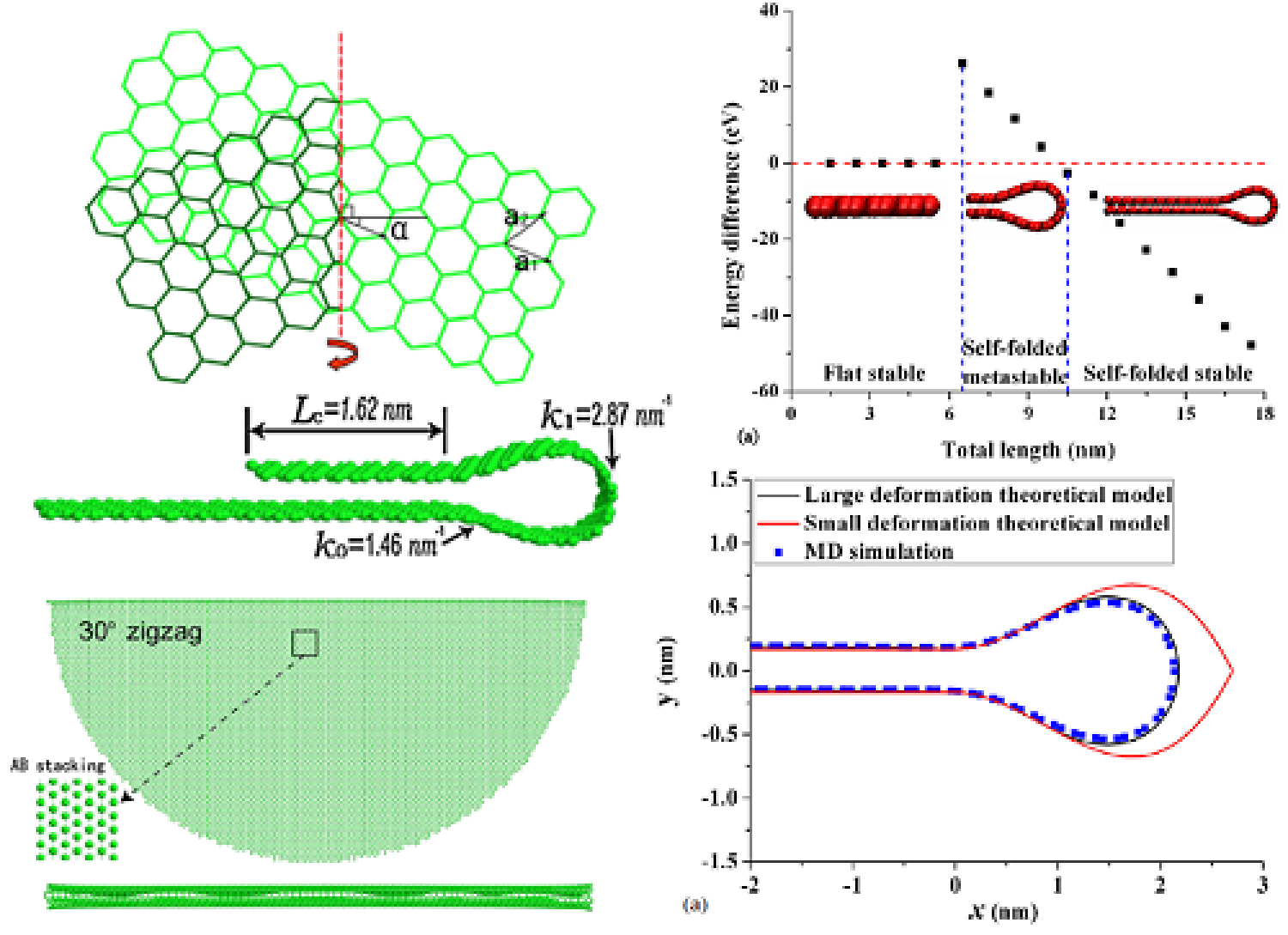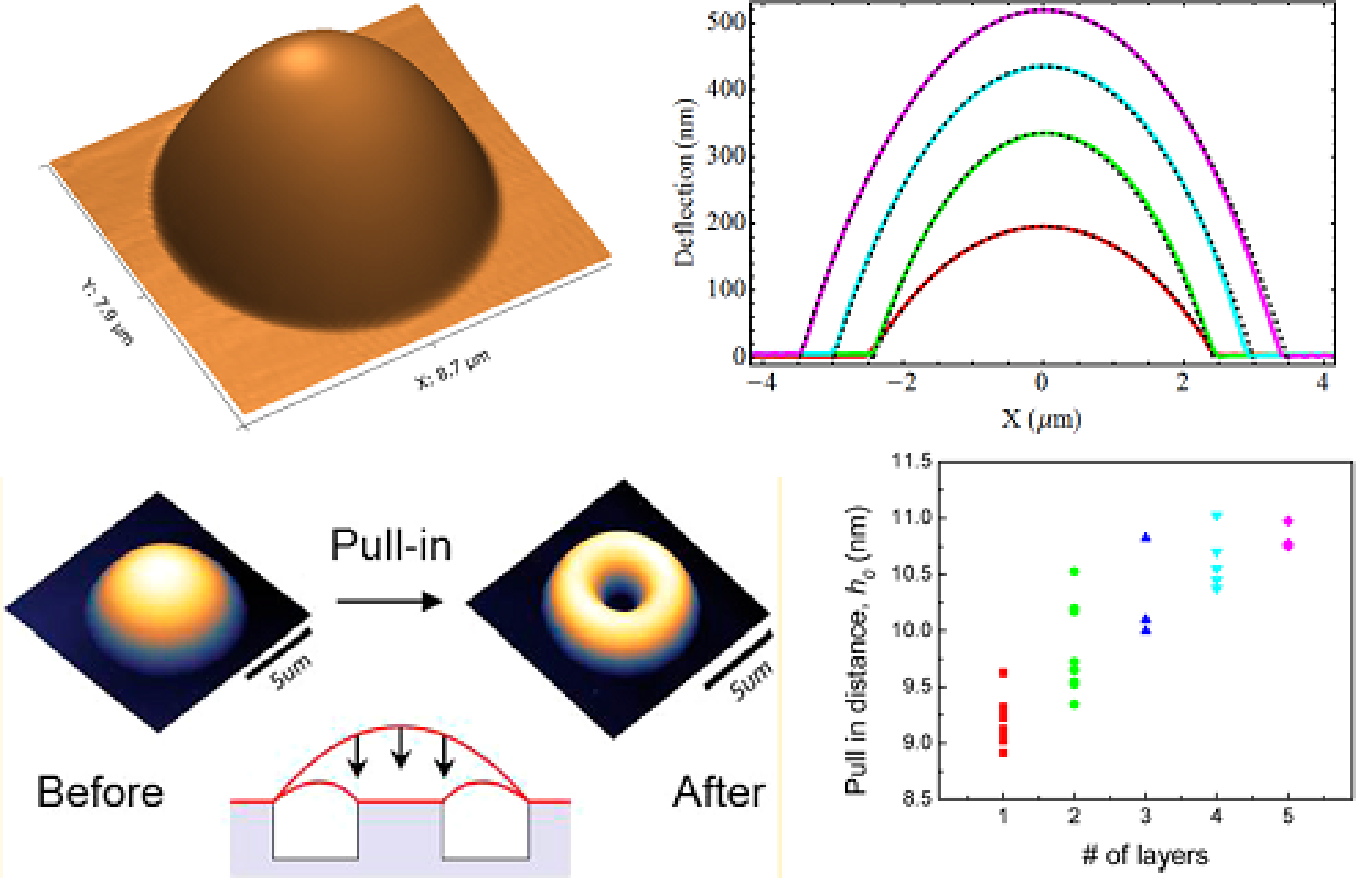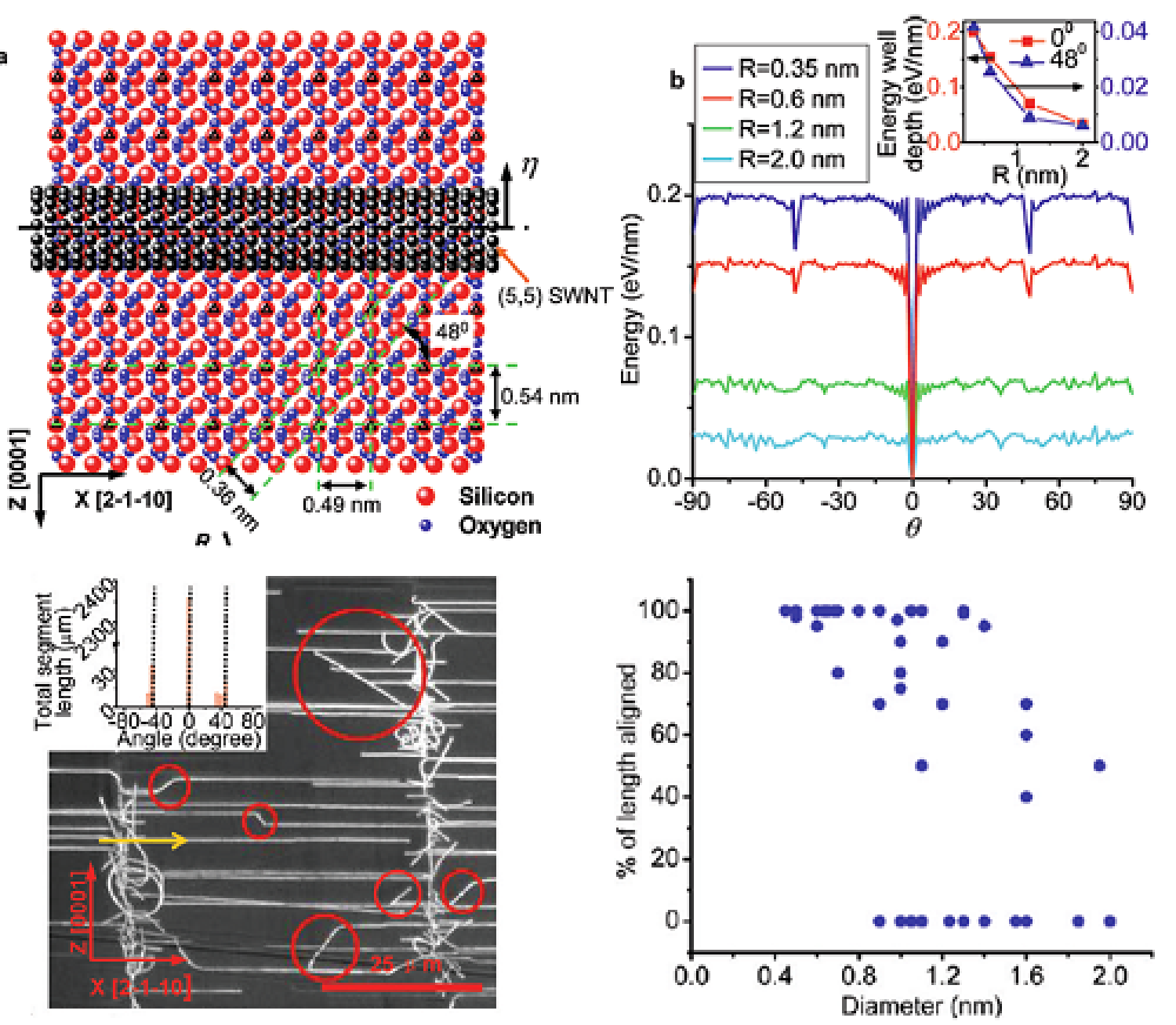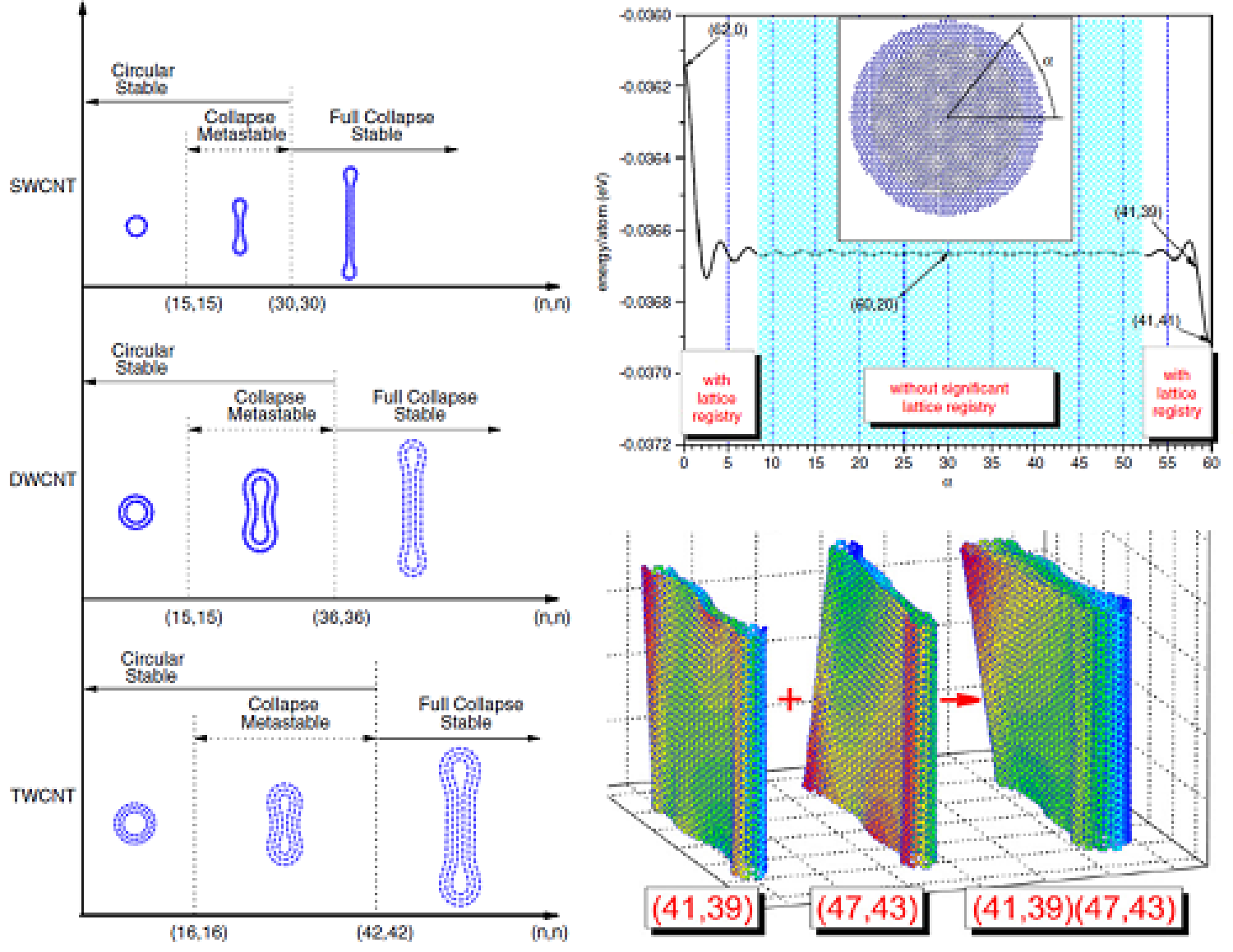Due to their attractive mechanical, electrical and optical properties, nanomaterials have attracted a lot of research interest. We are especially interested in the mechanics of nanomaterials, including nanotubes, nanowires, and graphenes. The non-specific van der Waals interaction, which is considered very weak forces in macroscale, can play dominating roles in the mechanical behavior of nanomaterials. We study the mechanical deformation of nanomaterials caused by this van der Waals interaction, which could have important implications on the application of nanomaterials in materials, electronics and optics.
Self Folding of Graphene
Graphene, like a sheet of paper, folds under mechanical forces. The folded graphene edges can affect the electrical properties of graphenes. The stability of folded graphene, however, depends on the folding direction and the resulted graphene stacking. Suspended graphene in liquids folds freely under random ultrasonic stimulations. We determined the structure of ~100 folded graphene edges by electron nanodiffraction. About 1/3 are armchair and 1/3 are zigzag. The results are explained by the energetics of graphene folding and atomic simulation. The zigzag edge has AB stacking, while in the armchair edge, AB stacking is achieved in some areas by a small twist. An analytical model based on finite deformation mechanics was also developed to accurately describe the shapes of folded edges.
References:
- J. Zhang, J. Xiao, X. Meng, C. Monroe, Y. Huang, and J.-M. Zuo, Free Folding of Suspended Graphene Sheets by Random Mechanical Stimulation, Physical Review Letters 104, 166805 (2010)
- X. Meng, M. Li*, Z. Kang, X. Zhang, J. Xiao*, Mechanics of Self-Folding of Single-layer Graphene, J. Phys. D: Appl. Phys. 46, 055308 (2013)
Mechanics of Graphene Blisters
Graphene membranes are adhered to substrates with patterned microcavities of prescribed volumes. By controlling the gas pressure within the microcavity, the membrane can be made to bulge and delaminate in a stable manner from the substrate. We study the analytical mechanics of this system, which is combined with experimental measurement to determine the elasticity of graphene and the adhesion energy between a substrate and a graphene (or other two-dimensional solid) membrane. A different microcavity configuration with a post in the center was also used, to study the pull-in behavior of graphene, which allows the determination of interfacial forces between two-dimensional nanomaterials and substrates.
References:
- X. Liu, N.G. Boddeti, M.R. Szpunar, L. Wang, M.A. Rodriguez, R. Long, J. Xiao, M.L. Dunn, and J.S. Bunch, Observation of Pull-in Instability in Graphene Membranes under Interfacial Forces, Nano Letters (accepted)
- N. G. Boddeti, S. P. Koenig, R. Long, J. Xiao, J. S. Bunch, and M. L. Dunn, Mechanics of Pressurized Graphene Blisters, Journal of Applied Mechanics-Transactions of the ASME (accepted)
Alignment Controlled Growth of Carbon Nanotubes on Quartz
Single walled carbon nanotubes (SWNTs) possess extraordinary electrical properties, with many possible applications in electronics. Dense, horizonally aligned arrays of linearly configured SWNTs represent perhaps the most attractive and scalable way to implement this class of nanomaterial in practical systems. Recent work shows that templated growth of tubes on certain crystalline substrates yields arrays with the necessary levels of perfection, as demonstrated by the formation of devices and full systems on quartz. Here, we examine advanced implementations of this process on crystalline quartz substrates with different orientations, to yield strategies for forming diverse, but well-defined horizontal configurations of SWNTs. Combined experimental and theoretical studies indicate that angle dependent van der Waals interactions can account for nearly all aspects of alignment on quartz with X, Y, Z and ST cuts, as well as quartz with disordered surface layers. These findings provide important insights into methods for guided growth of SWNTs, and possibly other classes of nanomaterials, for applications in electronics, sensing, photodetection, light emission and other areas.
References:
J. Xiao, S. Dunham, P. Liu, Y. Zhang, C. Kocabas, L. Moh, Y. Huang, K.-C. Hwang, C. Lu, W. Huang and J. A. Rogers, Alignment controlled growth of single-walled carbon nanotubes on quartz substrates, Nano Letters 9, 4311-4319 (2009).
Collapse and Stability of Carbon Nanotubes
Carbon nanotubes (CNTs) usually possess circular cross sections. As the size increases, van der Waals interaction could cause CNTs to collapse to a dumbbell shape. The collapse and stability of carbon nanotubes (CNTs) have important implications for their synthesis and applications. While nanotube collapse has been observed experimentally, the conditions for the collapse, especially its dependence on tube structures, are not clear. We have studied the energetics of the collapse of single- and multi-wall CNTs via atomistic simulations. The collapse is governed by the number of walls and the radius of the inner-most wall. The collapsed structure is energetically favored about a certain diameter, which is 4.12, 4.96 and 5.76 nm for single-, double- and triple-wall CNTs, respectively. The CNT chirality also has a strong influence on the collapsed structure, leading to flat, warped and twisted CNTs, depending on the chiral angle.
References:
J. Xiao, B. Liu, Y. Huang, J. Zuo, K.-C. Hwang, and M.-F. Yu, Collapse and Stability of Single- and Multi-wall Carbon Nanotubes. Nanotechnology 18, 395703 (2007).





